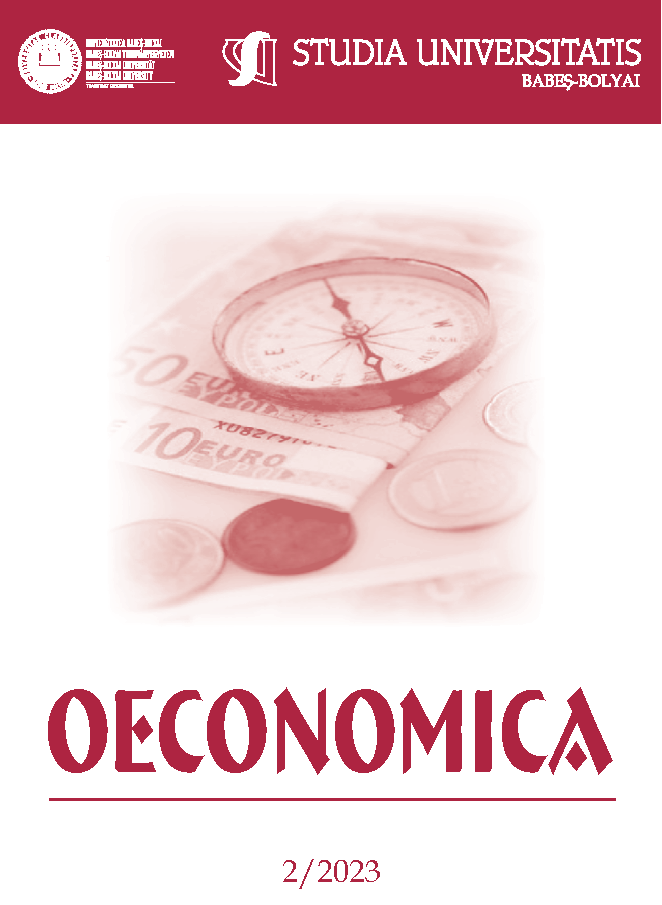THE EFFECTS OF GOVERNMENT EXPENDITURE ON THE OUTPUT: A REAL BUSINESS CYCLE ANALYSIS FOR THE ROMANIAN ECONOMY
DOI:
https://doi.org/10.2478/subboec-2023-0009Keywords:
economic growth, real business cycle model, Romanian economyAbstract
One of the most researched topics in macroeconomics is the development and implementation of Real Business Cycle models. This article presents a small Real Business Cycle model, which is built for the Romanian economy, with data from the 2nd quarter of 1995 through the 3rd quarter of 2022. The main aim of this analysis is to assess the historical influence of exogenous and government spending shocks on economic growth. In order to obtain accurate results, we implemented a Bayesian estimation technique for calculating the parameters of the model. The main findings indicate the significant exogenous shocks effect on the Romanian economy, and the way in which government spending had a positive effect on increasing economic growth for the period between the 1st quarter 2000 and the 3rd quarter of 2022.
JEL classification: E32, E60
References
Caraiani, P. (2007). An Analysis of the Fluctuations in the Romanian Economy using the Real Business Cycles Approach. Romanian Journal of Economic Forecasting, 4, 76-86.
Carboni, O.A., & Medda, G. (2011). Government spending and growth in a neoclassical model. Mathematics and Financial Economics, 4, 269-285. https://doi.org/10.1007/S11579-011-0045-2
Christiano, L. J., Trabandt M., & Walentin K. (2011). Introducing financial frictions and unemployment into a small open economy model. Journal of Economic Dynamics and Control, 35, 1999–2041.
Copaciu, M., Nalban, V., & Bulete, C. (2015). R.E.M. 2.0, An estimated DSGE model for Romania. https://www.dynare.org/wp-repo/dynarewp048.pdf
Data base for the Romanian economy: https://ec.europa.eu/eurostat/databrowser/view/NAMQ_10_GDP__custom_5007304/default/table?lang=en
Duarte, D., Galindo, H., & Montecinos, A. (2019). Leverage and capital utilization. The European Journal of Finance, 28, 801 - 824. https://doi.org/10.1080/1351847X.2021.1924215
Evans, G.W. (1989). Output and unemployment dynamics in the United States: 1950–1985. Journal of Applied Econometrics, 4, 213-237. https://doi.org/10.1002/JAE.3950040302
Fisher, J.D., & Peters, R.H. (2009). Using Stock Returns to Identify Government Spending Shocks. Macroeconomics: Monetary & Fiscal Policies eJournal. https://doi.org/10.1111/j.1468-0297.2010.02355.x
Galí, J., López-Salido, D., & Vallés, J. (2007.).Understanding the Effects of Government Spending on Consumption, Journal of the European Economic Association, 5, 1, 227–270, https://doi.org/10.1162/JEEA.2007.5.1.227
Garlappi, L., & Song, Z. (2017). Capital utilization, market power, and the pricing of investment shocks. Journal of Financial Economics, 126, 447-470. https://doi.org/10.1016/J.JFINECO.2016.11.006
Gecon Package for R: https://gecon.r-forge.r-project.org/
Gecon.estimation library for R: https://gecon.r-forge.r-project.org/ext_estim.html
Greenwood, J., Hercowitz, Z., & Huffman, G.W. (1988). Investment, Capacity Utilization and the Real Business Cycle. The American Economic Review, 78, 402-417.
Hansen, G.D. (1985). Indivisible Labor and the Business Cycle. Journal of Monetary Economics, 16, 309-327. https://doi.org/10.1016/0304-3932%2885%2990039-X
Keynes, J. M. (1936). The general theory of employment, interest and money. London :Macmillan
Kydland, F.E., & Prescott, E.C. (1982). Time to Build and Aggregate Fluctuations. Econometrica, 50, 1345-1370. https://doi.org/10.2307/1913386
Long, J., & Plosser, C.I. (1983). Real Business Cycles. Journal of Political Economy, 91, 39 - 69. https://doi.org/10.1086/261128
Lucas, R.E. (1976). Econometric policy evaluation: A critique. Carnegie-Rochester Conference Series on Public Policy, 1, 19-46. https://doi.org/10.1016/S0167-2231%2876%2980003-6
Ravn, M.O., Schmitt-Grohé, S., & Uribe, M. (2007). Explaining the Effects of Government Spending Shocks on Consumption and the Real Exchange Rate. International Finance eJournal. https://doi.org/10.3386/W13328
Sueppel, R. (2003). Comparing Economic Dynamics in the EU and CEE Accession Countries. European Central Bank Research Paper Series. https://doi.org/10.2139/ssrn.457535
Vasilev, A. (2018). The Role of Energy in a Real Business Cycle Model with an Endogenous Capital Utilization Rate in a Government Sector: Lessons from Bulgaria (1999–2016). Central European Economic Journal, 5, 130 - 141. https://doi.org/10.1515/ceej-2018-0011
Downloads
Published
How to Cite
Issue
Section
License
Copyright (c) 2023 Studia Universitatis Babeș-Bolyai Oeconomica

This work is licensed under a Creative Commons Attribution-NonCommercial-NoDerivatives 4.0 International License.



